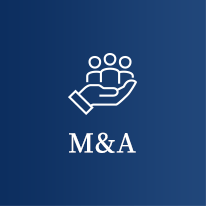Cases of Successful Sale of Businesses through M&A
Valuation of Stock Price in M&A (Cases of IT Companies and Mail Order Sales Companies)
IT companies and mail-order sales companies are considered to be industries where competition is intense due to the lack of special barriers to entry, and it is difficult to secure a certain level of sales unless the company has special products, technologies, or sales networks. However, even in such an environment, some presidents have increased sales and profits, and have earned large capital gains in the sale of their businesses through mergers and acquisitions. The following case study is a hypothetical example, but it shows that M&A has a high potential for success in an industry where the market environment is changing rapidly.
Background circumstances of M&A
Mrs. A quit her job at a medical equipment sales company 12 years ago and started her own business at the age of 30. At first, she became a sales agent for a health food company that was listed in the advertising section of a magazine, and has been selling health food products via the Internet. Mrs.A rented a room in an apartment near my home for 60,000 yen, hired several part-time employees, advertised on the website, delivered products to those who ordered them, and received payment for them. Although health food products are highly profitable, with a gross profit margin of about 70%, they have the drawback that they do not easily generate sales unless they are recognized by customers. For the first few years, annual sales remained almost unchanged at 3 to 6 million yen, and annual gross profit after deducting purchase costs was limited to 1 to 3 million yen. Deducting office rent and part-time labor costs from this amount left the company in the red every year, and it had to borrow money from its parents to make ends meet.
She learned that magazine advertisements targeting a specific target audience have a strong product appeal, so she decided to limit her advertisements to products that she particularly liked, and switched to a business of selling cosmetics through a mail order method. As the products sold well, the company shifted its advertising methods from magazines to TV shopping and Internet advertising, hired five full-time professional employees and increased the number of part-time employees to 20, and has now achieved annual sales of 1.2 billion yen.
Mrs. A’s company’s sales and operating profit are as follows.
Sales Operating Profit
2003: 3 million yen -1.5 million yen
2004: 3.5 million yen ▲1 million yen
2005: 6 million yen ▲2 million yen
2006: 5.5 million yen ▲2 million yen
2007: 12 million yen, 1 million yen
2008 35 million yen 2 million yen
2009: 80 million yen 15 million yen
2010 350 million yen 80 million yen
2011 880 million yen 260 million yen
2012: 1.2 billion yen 330 million yen
The strength of Mrs. A’s company lies in its ability to generate solid sales. In addition, the gross profit margin is very high due to the nature of the products, and the ability to reduce expenses by utilizing part-time workers is also attractive from the standpoint of profitability. She spends most of her time on advertising activities.
The most recent income statement of Mrs. A’s company is as follows
Net sales 1.2 billion yen
Cost of sales 450 million yen
SG&A expenses 430 million yen
Operating income 320 million yen
Non-operating income 20 million yen
Non-operating expenses 10 million yen
Ordinary income 330 million yen
After-tax profit 200 million yen
Valuation of Stock
Mrs. A’s company is unique in that its cost of sales is low in relation to its net sales, its operating income is remarkably high, and although it has not been in business for a long period of time, its sales have been increasing year by year. Company B, a major mail-order sales company, has made an offer to acquire Mrs. A’s company. The problem is how to value a company like Mrs. A’s company, which has made significant profits in recent years. There are various methods of valuing shares, so it is necessary to consider which method is most appropriate in this case.
Market Value Net Asset Value Method
This is the most common valuation method used in M&A of small and medium-sized companies, in which certain adjustments are made to the target company’s balance sheet to meet the objectives of the M&A, and the net asset value of the target company is calculated from the adjusted balance sheet. That amount, plus goodwill, is the acquisition price. Since the valuation is based on the assets accumulated in the company, it is also referred to as the cost approach. In this case, however, the net assets accumulated in the company are not that large, and the emphasis should be placed on how to value the increase in sales in recent years.
Comparable company method
This method evaluates the value of the subject company based on the aggregate market value of similar listed companies. If there is a similar listed company, the market capitalization of that listed company is divided by an index such as EBITDA or after-tax profit, and the EBITDA or after-tax profit of the subject company is multiplied by that multiple to calculate the stock price. For example, if a similar listed company has a market capitalization of 3 billion yen and EBITDA of 250 million yen, the multiple would be 12 times. If the subject company’s EBITDA is 125 million yen, then the value of the subject company’s shares would be 1.5 billion yen. The comparable company method is also known as the market approach. However, in this case, it is not always possible to identify comparable companies because the size of Mrs. A’s company is not as large as that of a listed company.
Income Capitalization Method
This method calculates the stock price by dividing the after-tax operating profit by the capitalization rate and adding adjustments. This method is also called the income approach because it focuses on a company’s earning power. In this case, the M&A is likely to be conducted focusing on the significant increase in sales and profits, so the income capitalization method, which focuses on earning power, is considered most appropriate.
Under the capitalization method, the share price is calculated by dividing the after-tax operating income by the capitalization rate and making certain adjustments. The capitalization rate is considered to be an investment yield that takes into account the subject company’s risk and other factors. In the case of the company in question, although profits are increasing every year, they are not constant and there is much room for fluctuation, and the business environment and market environment for online shopping must be taken into consideration. Even if the market interest rate is extremely low, the investment is relatively risky from the investor’s point of view, so a return of 10% to 15% is probably required. Of course, there is no set rule as to what percentage the capitalization rate should be. In the end, it is a matter of negotiation between the seller and the buyer.
Therefore, assuming that the capitalization rate is 10%, the stock price using the income capitalization method would be as follows (assuming 300 million yen in the balance of bank account and 500 million yen in loans).
Ordinary income on the income statement: 330 million yen
Execution tax rate 40
Corporate tax on ordinary income 130 million yen
Ordinary profit after tax 200 million yen
Return on capital 10%.
Capitalization rate 200 million yen / 0.10% = 2 billion yen
Addition of the balance of bank account 300 million yen
Reduction of loans 500 million yen
Adjusted price 2 billion yen + 300 million yen – 500 million yen = 1.8 billion yen
Therefore, the value of Mrs. A’s company stock is 1.8 billion yen, and while Mrs.A has a desire to increase sales and expand the company in the future, he has had a lot of hardships in the past as a small company, so she would like to secure funds through the sale of the company and then look at his future life. After much deliberation, Mrs. A finally decided to accept Company B’s takeover offer.
Taxation of Gain on Stock Transfers
Since the sale price of Mrs. A’s shares is 1.8 billion yen, the remaining amount (e.g., 1.79 billion yen) after deducting the acquisition cost of the shares (e.g., 10 million yen) is the gain on the transfer of shares, and Mrs. A is subject to capital gains tax of 20% (358 million yen) on the 1.79 billion yen by separate declaration taxation. Mrs. A will be subject to capital gains tax of 20% (358 million yen) on 1,790 million yen. In the end, Mrs. A’s net income will be 1,790 million yen + 10 million yen – 358 million yen = 1,442 million yen.
Execution of consultancy agreement
When a company’s representative rapidly expands the company, as in this case, the company’s sales and sales strategies are extremely dependent on the representative’s abilities, and the acquiring company often requests that the representative continue to be involved in the company’s management as a representative (or as an advisor). In such cases, Mrs. A should clearly state the conditions under which she will be employed by the acquiring company (e.g., as an advisor to the former company, she will work for the company at least three days each week for at least six months after the completion of the acquisition to cooperate in sales policies and marketing activities, the company will pay Mrs. A ¥2 million per month in compensation for her labor, etc.).
The above is an explanation of an M&A of a company that has significantly increased its earnings based on a case study of a mail-order sales company, but the acquiring company also has significant advantages, such as the ability to instantly increase its own sales and to bring in people with outstanding sales policies and strategies to increase sales of its products. This is a major advantage. Therefore, similar M&A transactions are often conducted not only in the mail-order business using the Internet or TV shopping, but also in IT-related companies and restaurant chains.
In the cases we have handled, unlike business succession or revitalization-type M&A, young managers who have grown their companies in their own lifetime have sold their companies and used the proceeds to consider the next investment target, or have used M&A from a proactive perspective to gain access to a listed company to enable greater sales or research and development. In the U.S., more and more people are thinking of selling their companies to obtain a large amount of funds from the sale, retire early, or increase the size of their assets by making the next investment.










